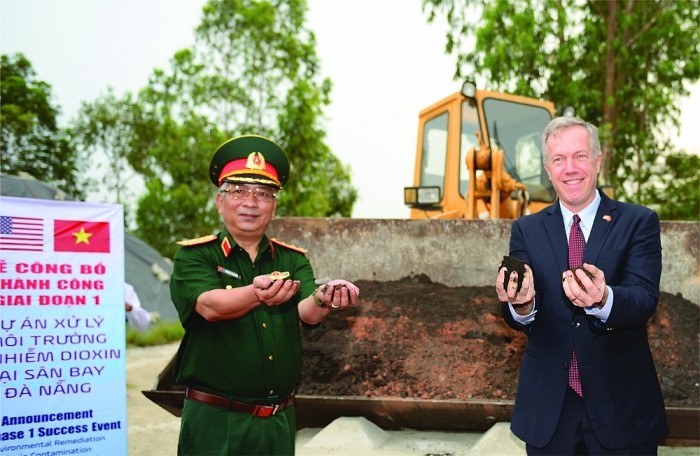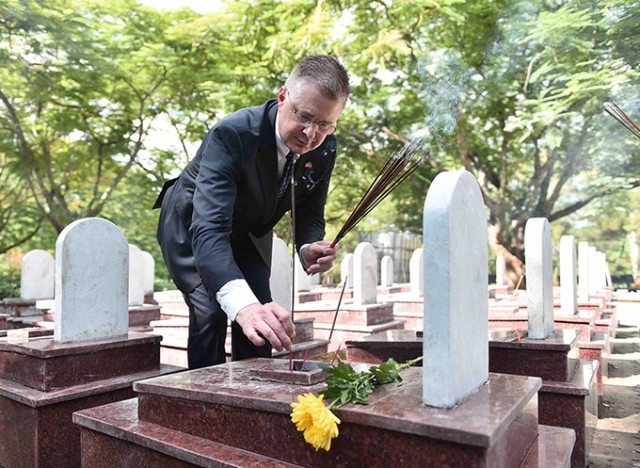(VOVWORLD) - In the spring of 1975, "the longest war in American history" waged by the US military in Vietnam, came to an end with the historic Ho Chi Minh campaign. Over 46 years since the Vietnam-US relationship has shifted from confrontation to dialogue, from adversary to friend, and evolved into a Comprehensive Partnership, thanks to efforts by both sides to neutralize hatred, build trust, and join hands to resolve the consequences of war in a constructive spirit.
 Deputy Minister of Defense Nguyen Chi Vinh and former US Ambassador to Vietnam Ted Osius holding a handful of soil that has been completely decontaminated at Da Nang Airport. (Photo: Ministry of Foreign Affairs) Deputy Minister of Defense Nguyen Chi Vinh and former US Ambassador to Vietnam Ted Osius holding a handful of soil that has been completely decontaminated at Da Nang Airport. (Photo: Ministry of Foreign Affairs)
|
Remedying war consequences has been an important part of the relationship since Vietnam and the US normalized their diplomatic ties in 1995. Both are committed to cooperating in the fulfillment of humanitarian obligations.
Severe consequences of the war
Although the war ended 46 years ago, its consequences remain evident, from the injuries of veterans and civilians, and the illnesses and malformations of toxic chemical victims, to family separations, from completely deformed vegetation to land contamination with unexploded ordnance. Those who survived the war continue to face serious economic, social, and environmental problems. Vietnam has the highest rate of birth defects in the world.
The US and its allies also suffered human losses and mental health problems. Hundreds of thousands of people returning home have suffered from post-traumatic stress disorder (PTSD). The number of US soldiers afflicted with mental illness during and after the Vietnam War is the highest of all the wars US military has fought.
Fulfillment of humanitarian obligations
In 2006, Vietnam and the US signed a Memorandum of Understanding on a health and environmental treatment program to deal with Agent Orange/dioxin in Vietnam, an important milestone in finding solutions to a difficult problem. In 2012, the US Agency for International Development (USAID) partnered with Vietnam’s Ministry of Defense to implement the project to clean up dioxin contamination at Da Nang airport. After completing this project in 2018, both sides continued with a similar project at Bien Hoa airport.
 US Ambassador to Vietnam Daniel Kritenbrink offers incense on a soldier's grave at Truong Son National Martyrs Cemetery. (Photo: US Embassy) US Ambassador to Vietnam Daniel Kritenbrink offers incense on a soldier's grave at Truong Son National Martyrs Cemetery. (Photo: US Embassy)
|
Two years later, the US committed 65 million USD over five years to give people with disabilities in eight Vietnam provinces greater opportunities for social inclusion and an improved quality of life.
Former US Ambassador to Vietnam Daniel Kritenbrink said, “When we start with our cooperation on humanitarian and legacy of war issues, we really do believe that even our partnership today is very much focused on the future, we have the responsibility to also address issues from the past.”
“And one important area related to our past history is our joint effort to clean up dioxin or Agent Orange contamination from the war. We are treating people with disabilities in the eight provinces most heavily sprayed by Agent Orange during the war. And of-course our two countries are also working hard together to account for missing on both sides from the war,” said Kritenbrink.
Over the past decade, the US has given Vietnam hundreds of millions of USD to overcome war consequences. Reciprocally, Vietnam has helped the US locate the remains of thousands of soldiers missing since the war.
Deputy Minister of National Defense Nguyen Chi Vinh said, “The US greatly appreciates Vietnam's cooperation in searching for Americans missing in action. This is an area of cooperation we are very proud of. We do it out of humanity, responsibility, and trust.”
Remedying war consequences has helped relationship normalization and improvement and trust building between Vietnam and the US. To achieve today's fruitful cooperation has required consistency in action, wisdom, a strategic vision, and a strong belief in a bright future. This is not only a model of reconciling two former foes, but also a solution to many of the current regional and global conflicts.